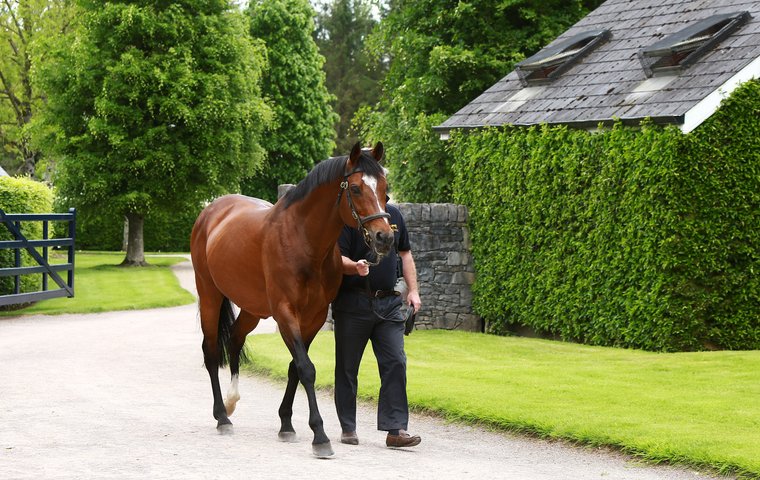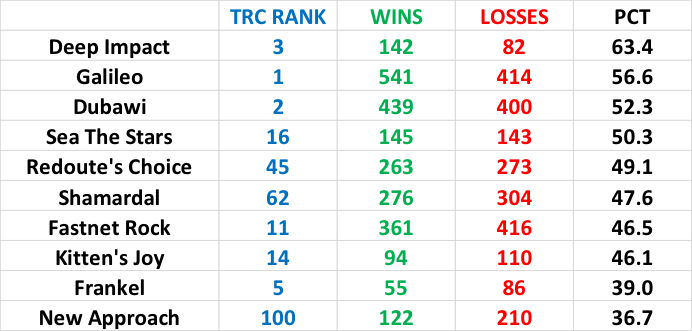
TRC Global Rankings are different from many others in the world of sport because they are designed to be predictive. Every week, the system looks at all head-to-head match-ups between Jockeys, Owners, Trainer and Sires and tests its own predictions, learning from the results.
In some ranking systems, the way players and teams from round the world are arranged is highly arbitrary. The compilers select coefficients to weight the results in various countries or tours, so that the result tallies with intuition. TRC Global Rankings are having none of this.
So, in the week of The Derby and The Oaks at Epsom, let’s test the theoretical predictions of the rankings of leading sires on turf against actual results achieved around the world. We have chosen ten stallions who have runners in Saturday’s Derby or Friday’s Oaks and compared the record of their progeny in actual head-to-head competition in Group races around the world since 2011.
Here are the competitors:
Galileo, 20yo, stands Coolmore Stud, Ireland; sire of four Oaks runners and three Derby runners.
Deep Impact, 16, stands Shadai Stallion Station, Japan; sire of Derby favourite Saxon Warrior.
Sea The Stars, 12, stands Gilltown Stud, Ireland; sire of Derby runner Knight To Behold
Kitten’s Joy, 17, stands Hill ‘n Dale Farms, USA; sire of Derby second favourite Roaring Lion.
Shamardal, 16, stands Kildangan Stud, Ireland; sire of Derby runner Hazapour.
New Approach, 13, stands Dalham Hall Stud, Britain; sire of Derby runner Masar.
Redoute’s Choice, 21, stands Haras de Bonneval, France*; sire of Derby runner Sevenna Star.
Frankel, 10, stands Banstead Manor Stud, Britain; sire of one Oaks runner and one Derby runner.
Fastnet Rock, 16, stands Coolmore Stud, Ireland; sire of Oaks runner I Can Fly.
Dubawi, 16, stands Dalham Hall Stud, Britain; sire of Oaks favourite Wild Illusion.
(* Location of sires as per racingpost.com on May 30, notwithstanding other shuttle locations.)
The competitors were evaluated by all head-to-head meetings between their offspring in Group races, with one win awarded to the sire whose runner finished first. Where sires had multiple runners, no debit is made for the number of runners because the mere presence of a runner in a Group or Graded races is a positive sign for a stallion.
TRC Global rankings points are awarded based on performance in ALL Group and Graded races, weighted by the quality of the opposition in those races and their rarity value. In this exercise, we will examine the specific interaction between only the best sires on turf.
You could think of the difference like this: TRC Global Rankings is like the Premier League table after each team has played all other teams; that is, with an equal strength of schedule. In this exercise, we are looking at games between the top few teams only, removing performance against the rest of the league. Here are the results in a matrix:

This is how to read the results matrix. In each row, are the number of head-to-head results won by the stallion. So, for instance, looking along Shamaardal’s row to the rightmost column, one finds his stock won 65 head-to-head match-ups with the stock of Dubawi in races all round the world. To find the reciprocal results – how many times Dubawi’s stock beat Shamardal’s – look along the final row to the column headed by Shamardal. The answer is 78. So, in head-to-heads between the stock of the two stallions, Dubawi won 65 and Shamardal 78.
I n the margins of the column, the aggregate of each stallion's WINS and LOSSES can be found. Alongside is a tabulated form of these results, ranked by PCT – the winning percentage in all these head-to-head encounters:
n the margins of the column, the aggregate of each stallion's WINS and LOSSES can be found. Alongside is a tabulated form of these results, ranked by PCT – the winning percentage in all these head-to-head encounters:
The main findings can be summarised as follows:
The world’s top 3 stallions according to TRC Global Rankings duly finished 1-2-3. But Deep Impact (63.4%) – a former world #1 – comes out a lot better than Galileo (56.6%) and Dubawi (52.3%). From the matrix, one can see that the great Japanese stallion has gone 29-20 v Galileo in the 49 races where they have both had a runner and 14-11 v Dubawi in the 25 races in which both their stock has been represented.
Should the algorithm therefore have Deep Impact above Dubawi and Galileo, rather than behind them? What we are doing here is removing the vast majority of Deep Impact’s results at home in Japan and on dirt. His dam, Wind In Her Hair, was a turf horse with turf breeding who finished second in the 1994 Oaks at Epsom. Could Deep Impact turn out to be a stallion whose stock are well suited to racing in Europe on turf?
While this exercise provides nothing like the evidence to say this definitively, it is an interesting prospect, especially considering that he is the sire of Coolmore’s Derby favourite Saxon Warrior – a colt out of a mare by Galileo, no less. All being well, we are poised to see a lot more examples of this cross in future.
But we still should not rank Deep Impact ahead of Galileo and Dubawi bearing in mind the other data we consider for the rankings. It’s just not safe to do so. We are still betting on Galileo in future match-ups with Deep Impact when the latter becomes more widely represented. The encouraging thing is that the top 3 stallions collectively dominate this exercise, just as they do the main rankings.
Frankel does less well than expected, winning just 55 of his 141 match-ups. This is also extremely misleading, but for a different reason. Of those 141 head-to-heads, the matrix shows that 96 have come against Galileo (44), Dubawi (27) and Deep Impact (25)!
Redoute’s Choice fared better than his overall TRC ranking. Again, however, this is a function of strength of schedule. Of the 536 match-ups in which he was involved, 269 were against Fastnet Rock (in which Redoute’s Choice went 115-124) who won only 46.5% of his match-ups in general. Against the top 3 stallions, Redoute’s Choice went 37-25 v Galileo, 46-48 v Dubawi and 6-26 v Deep Impact. In aggregate, the Arrowfield legend has gone 89-99 against the Top 3.
Our main TRC Global Rankings algorithm attempts to equalise strength of schedule across all a stallion’s head-to-heads using machine learning. When we allow for this in the results of the head-to-heads in this exercise, the results are highly similar. And this is what we would hope to see.
The TRC algorithm makes millions of computations just like the ones involved in this exercise every week, sorting the world’s top Jockeys, Owners, Trainers and Sires into an order that really does reflect their results in head-to-head match-ups when they occur.


